15 reasons why St Lucia is the perfect Caribbean island
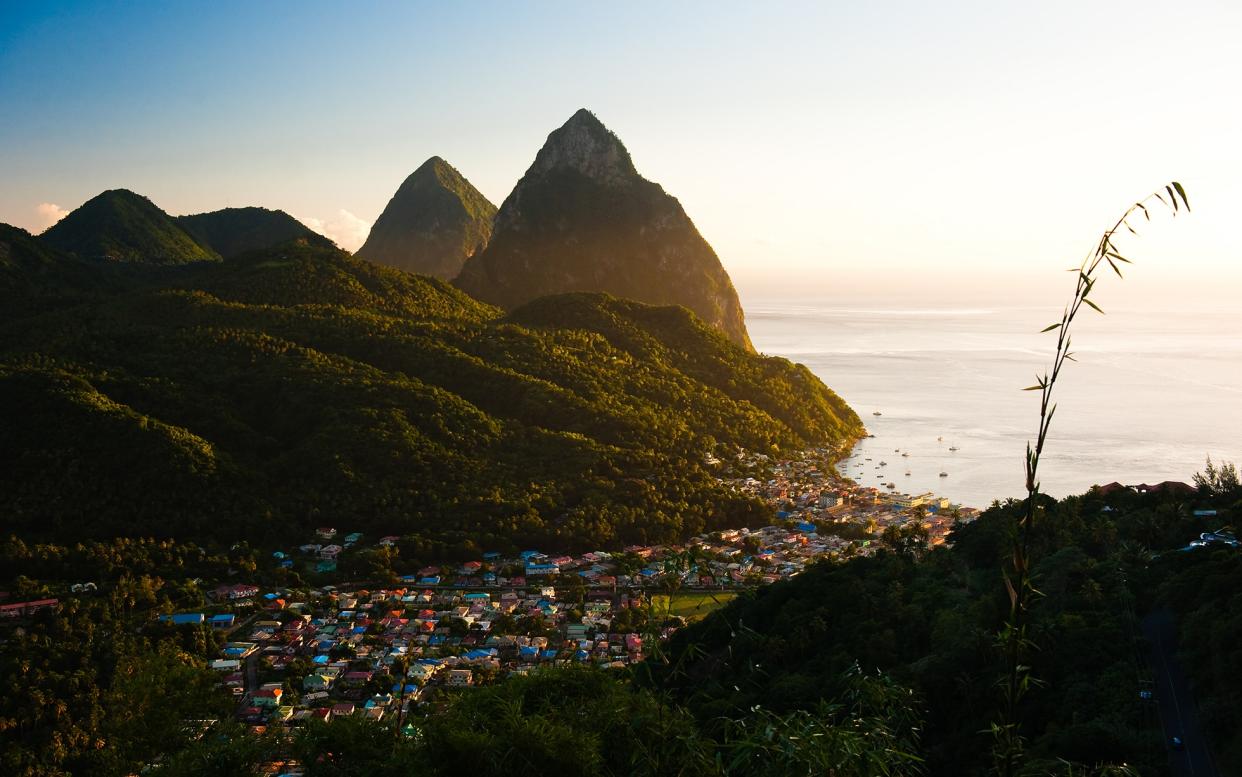
More than 7,000 individual islands, including 13 sovereign nations and 12 dependencies, make up the sun-soaked Caribbean – so picking just one is a tricky task. Some suit beachgoers, while others are made for adventure. There are islands for history buffs, naturalists, night owls and lovers of luxury. St Lucia - which celebrates 40 years of independence today - offers a little of everything, making it the perfect option for first-time visitors to the region.
1. There’s the best view in the Caribbean
Few coastlines have been photographed more than St Lucia’s spectacular south-west corner. The Pitons, a pair of jagged volcanic peaks that planes must skirt around to touch down at the island’s international airport, are instantly recognisable – but up close they look unreal, like Hollywood’s CGI wizards have been let loose. Try to find accommodation nearby – it’s not a view you’ll grow tired of.
2. And the most fantastic hotel location imaginable
Every hotelier on the island must cast envious eyes at Sugar Beach. Backed by dense forest and with its own strip of perfect white sand (Anse Piton), it nestles against Petit Piton - with an almost sheer rock wall soaring from the property’s doorstep to the 739-metre summit - and boasts unbeatable views of its big brother, Gros Piton.
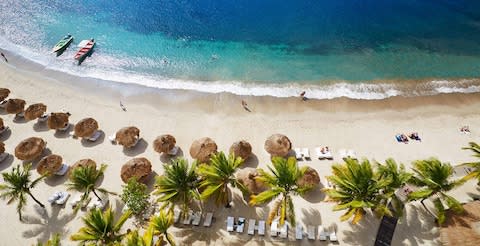
With such an incredible position it would be easy for the hotel to rest on its laurels, but service is impeccable, and the minimalist rooms - some by the beach, others on a hillside overlooking it - are immaculate.

The spa is a highlight. Hotels around the world trip over themselves trying to recreate that “rainforest” feel. Here it’s the genuine article, with cabanas hidden among the trees and connected by wooden walkways, and the soundtrack of birdsong and trickling water delivered live.
A clutch of tuk-tuks ferry guests up and down the steep roads that link the villas, beach, public areas and restaurants (be sure to find time for the Great Room’s wonderful tasting menu); personal butlers are on hand to deal with requests and deliver daily treats.
The pampering, and the premium location, doesn’t come cheap – this is somewhere for very special occasions.
Sugar Beach
Soufriere, Saint Lucia
9Telegraph expert rating
Nestled between St Lucia's landmark Pitons on a former sugar plantation, this luxurious hotel occupies one of the most memorable spots anywhere in the Caribbean. With white-on-white interiors, the accommodation is gorgeous; other highlights include a forest spa with treehouse treatment gazebos. Read expert review From £444per night Check availability Rates provided by Booking.com
3. There are fine sandy beaches
Despite the island’s volcanic origins, the sand on its beaches is golden. Anse Piton is a contender for the best in the entire Caribbean – never mind that they’ve cheated somewhat by importing fine white grains from Guyana. It is also, like all St Lucia’s beaches, open to the public (so you needn’t be a guest at Sugar Beach to enjoy the view).
There are more gorgeous beaches along the west coast, such as Anse Chastanet (home to a hotel of the same name) and Anse Cochon. Even further north, Marigot Bay is a picturesque natural harbour that attracts posh yachts and has a small isthmus of sand, while mile-long Reduit Beach, beside the tourist town of Rodney Bay, is the biggest, and most popular, on the whole island.
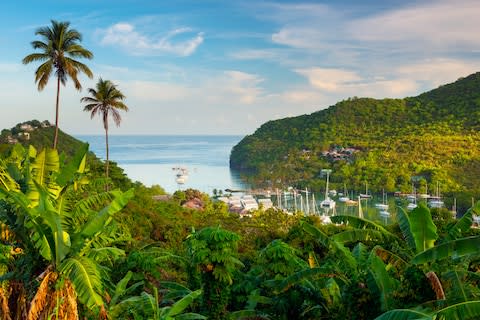
4. And life under the water
Inspired by Blue Planet II? The reef at Anse Piton, close to the surface so ideal for snorkelling, is home to a wealth of watery wonders. Expect to see sinister trumpetfish hoping to ambush tiddlers, shoals of little squid, slippery moray eels lurking within the coral, gormless looking parrotfish, and scores of curious needlefish.

On the opposite side of Petit Piton, and just north of the island’s former capital, Soufriere, Scuba St Lucia leads dives to a dozen spots on the south-west coast. Highlights include the wreck of the freighter Lesleen M, which sits 30 feet below the surface; night dives, when crustaceans and octopuses come out to play; and trips to Turtle Reef, where hawksbill and green turtles go to graze on seagrass.
5. You can scale mountains
At 798 metres, it’s hardly colossal (England’s highest peak, Scafell Pike, reaches 978 metres), but the heat and humidity make the hike up Gros Piton a proper challenge – expect sore muscles and a John Wayne-style gait the next morning.
Hire a local guide from the quaint little village at its base, bring plenty of water, watch your footing on the steep muddy slopes, and keep your fingers crossed for a clear day – cloud cover has a habit of spoiling the view.
A post shared by Olly Smith (@oliver_smith_83) on Dec 5, 2017 at 12:24pm PST
6. And fly through the rainforest canopy
For those who want more than a tan from their holiday, St Lucia couldn’t be better. Around 77 per cent of it is covered in forest (by comparison, the figure for neighbouring Barbados is just 19 per cent, while for Antigua it’s 22 per cent). So escape the beach and start exploring.
Quick and easy options include the Tet Paul Nature Trail, close to the base of Gros Piton, and the well maintained Diamond Falls Botanical Gardens, on the outskirts of Soufriere. For something more challenging, venture to the interior. Guided hikes from the Millet Bird Sanctuary, in the centre of the island, and the Edmund Forest Reserve, a little further south, offer the chance to spot dozens of the country’s 186 feathered species, including the rare St Lucia parrot and a clutch of tiny hummingbirds, with idyllic waterfalls, beautiful orchids, giant ferns and strangler figs providing the backdrop.
Throw in a few thrills by visiting the Rainforest Adventure, around a 20-minute drive inland from the capital, Castries. A gondola takes guests deep into the jungle, where a series of treetop platforms, linked by zip wires, await. It’s a little touristy, but the guides are passionate and knowledgeable – and youngsters are certain to love it.
7. It’s an unlikely place for cycling
You won’t see many cyclists in St Lucia – the propensity for one-in-three gradients on its twisting, potholed lanes see to that. But there is an off-road option. Just north of Anse Chastanet lies Anse Mamin, behind which you’ll find the remains of a sugar plantation. The sprawling site, bisected by a river and dotted with ruined and overgrown buildings, where slave labourers endured unimaginable hardships, is now an atmospheric setting for mountain biking. There are eight miles of tracks for all levels, including the absurdly tough Tinker’s Trail, designed by a former professional mountain bike racer, Tinker Juarez.
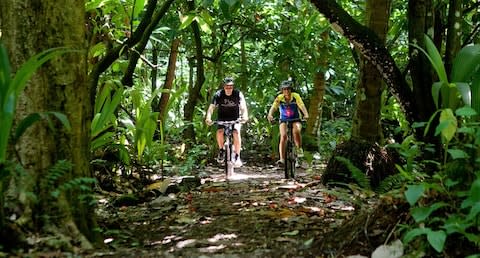
8. It’s heaven for chocolate lovers
Hotel Chocolat, Britain’s poshest chocolatier, sources cocoa from its own plantation on the island, the Rabot Estate near Soufriere. Since 2011 it has been home to a 14-room hotel and restaurant, Boucan, where, unsurprisingly, chocolate features heavily on the menu. Sign up for one of its three-hour “bean to bar” tours to learn all about cocoa production, pick and taste fresh pods, graft your own plant, and then smash dried beans to make a chocolate bar (it’s a surprisingly sweaty business).
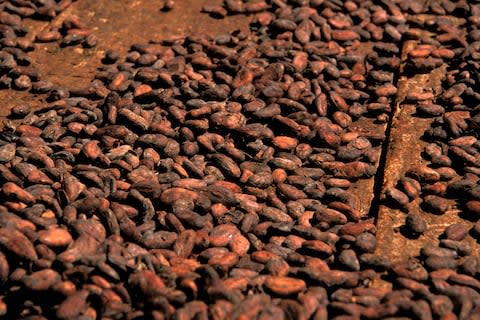
9. There’s history
Pigeon Island, in the far north, contains the ruins of Fort Rodney, built by the British in the 18th century and converted into a US signal station in the Second World War. Views from the hilltop redoubt are very special.
10. The welcome is warm
Expect to find eccentric characters in every corner (such as Cuthbert, a guide at Boucan who has a charming habit of referring to himself in the third person), and a touching and infectious pride in the island’s flora and fauna, agriculture, attractions, and intellectuals (St Lucia has more Nobel Prize winners per capita than any other nation).

11. You can stay out late
Should you wish to sample more rum and Piton beer than is strictly necessary, head to the fishing village of Gros Islet for its Friday night street party. Stalls sell barbecued fish and chicken while loudspeakers belt out Caribbean beats. For something a little more family-friendly, try Anse La Raye’s Friday fish fry.
12. There are fewer hurricanes
Hurricanes do reach St Lucia, of course, but its southerly location means it tends to escape the very worst of the stormy weather, as it did in 2017 when Hurricane Irma wreaked devastation a little further north.
13. They drive on the left
A minor point, but one that will satisfy UK travellers. Being a former British colony, they drive on the left in St Lucia. If you’re planning to escape the sunlounger and explore the island, hiring a car is a very good idea. And, given the state of some of the roads, hiring an off-roader is an even better one. Sixt, with an office at Hewanorra International Airport, has a fleet of Suzuki Jimnys.
14. It has the world’s only drive-in volcano
Another good reason to hire a car. Sulphur Springs calls itself the world’s only “drive-in volcano”. Park up, soak in a mud bath, admire the boiling, steaming crater, and hold your nose – the whole place reeks of rotten eggs.

15. Airlines fly direct
St Lucia is a simple eight-hour direct flight from the UK. No transfers, no fuss. And in winter it’s just four hours behind GMT (compared with five hours in Jamaica, Cuba and the Bahamas) – so jet lag is less of an issue. Fly from Gatwick with Virgin Atlantic.
For more information on St Lucia see www.saintluciauk.org



